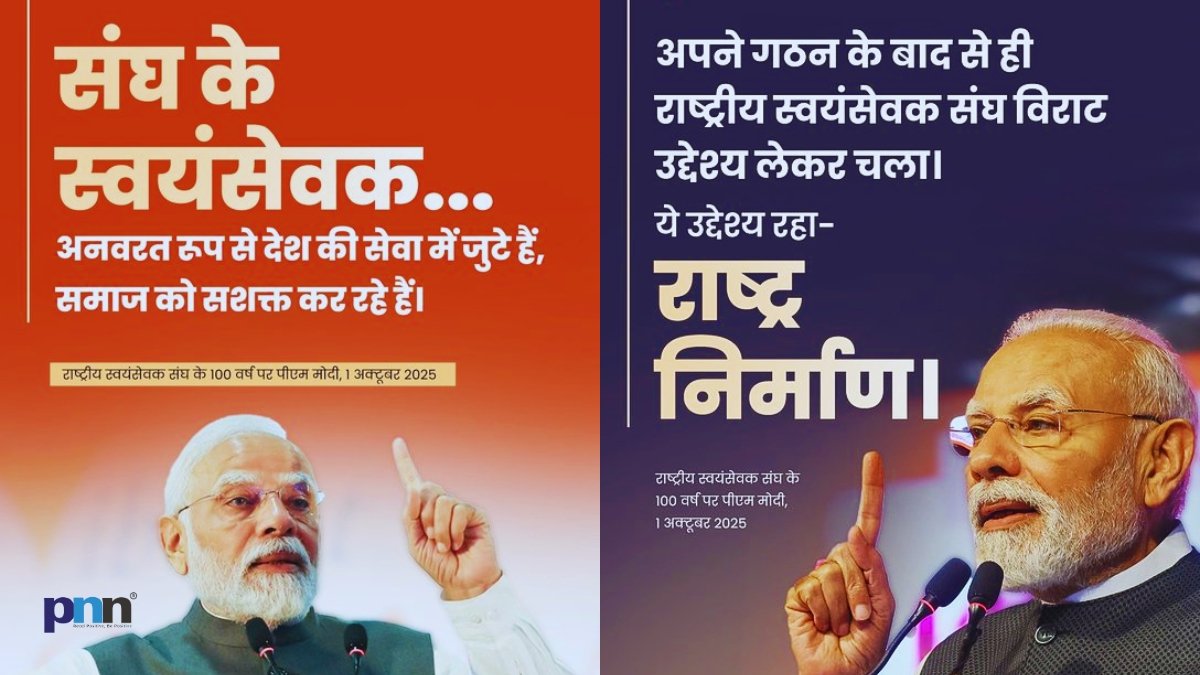New Delhi [India], October 1: A hundred years is a long time to prove a point. And the Rashtriya Swayamsevak Sangh (RSS) just pulled it off in front of the nation. At the grand centenary celebrations in the capital, Prime Minister Narendra Modi didn’t just attend, he stamped (literally) the Sangh’s century-long legacy with a commemorative coin and postage stamp. (RSS Centenary Celebrations)
He called the RSS a “virtuous incarnation of India’s national consciousness.” That’s PM Modi-speak for: this organization has been in the trenches of India’s journey, weathering crises, building communities, and shaping the nation’s social muscle since 1925.
RSS Centenary Celebrations: A Hundred Years in Uniform
Founded during Navratri in 1925 by Dr. Keshav Baliram Hedgewar, the RSS has grown from a handful of men in khaki shorts to one of the world’s largest volunteer-driven movements. PM Modi, speaking at Delhi’s Dr. Ambedkar International Centre, reminded everyone that the Sangh isn’t just an outfit with daily drills, it’s a mindset.
“The Sangh is not merely an organization, it is a flow of service, patriotism, and discipline that has touched every sphere of Indian life,” PM Modi said.
From schools to relief camps, shakhas to service programs, the RSS has built a footprint so wide it’s hard to ignore.
Stamp. Coin. Symbol. Legacy.
The Government of India marked the centenary with two firsts that carry weight:
- The ₹100 Commemorative Coin: Featuring Bharat Mata in Varad Mudra, saluted by swayamsevaks. This is the first time Bharat Mata appears on Indian currency. The symbolism is not lost, “Nation First” minted in metal.
- The Special Stamp: A throwback to the 1963 Republic Day parade, when RSS swayamsevaks marched in uniform.
PM Modi called them more than mementos. They are statements. The Sangh’s motto, Rashtraya Swaha, Idam Rashtraya, Idam Na Mama (For the Nation, Not for Me), now sits in the palm of every coin collector and philatelist.
RSS as a River of Service
If the RSS were a river, it would be the Ganga, branching, nourishing, and not always loved by everyone, but undeniably central. PM Modi painted the same picture:
- Education: Vidya Bharati schools spread across the country.
- Healthcare & Tribal Upliftment: Vanvasi Kalyan Ashram, Seva Bharati, clinics in remote corners.
- Rural Empowerment: Agricultural and village initiatives keeping Bharat connected to its soil.
- Women’s Empowerment: From cultural programs to welfare drives, a quieter but consistent thread.
The Prime Minister boiled it down to one uncompromising principle: Nation First.
The Shakha Effect
If you want to understand the Sangh, you need to understand the shakha.
Picture it: a field at dawn, men and boys in disciplined rows, sticks in hand, voices raised in unison. It looks simple. But that daily ritual of drills, debates, and discipline is where RSS volunteers are forged.
PM Modi called the shakha a “sacrificial altar of character-building,” where selfishness gets burned off and replaced with collective responsibility. In Sangh lingo, it’s the transformation from “Me” to “We.”
The Prime Minister outlined three pillars of this century-long model:
- Vision of nation-building
- Path of personal development
- Daily shakha as the method
Sweat, Sacrifice, and Struggles
Critics often forget one fact: the Sangh hasn’t been a spectator in India’s struggles. PM Modi reeled off a list:
- Freedom Movement: Hedgewar and many swayamsevaks jailed.
- Quit India, 1942: Atrocities faced by RSS workers in Chimur.
- Partition, 1947: Relief camps for displaced families.
- 1962 and 1971 Wars: Civil support for soldiers and refugee care.
- Liberation of Hyderabad & Goa: RSS volunteers in the thick of it.
- Emergency, 1975: Standing up when democracy was under lock and key.
“Whether in times of war, natural disaster, or social upheaval, swayamsevaks have always been first responders,” PM Modi reminded.
Firefighting in Real Time
When India trembles, swayamsevaks show up. That’s been the pattern.
- 1956 Gujarat Earthquake: Relief camps set up within hours.
- 1984 Sikh Riots: RSS volunteers worked with Sikh families at a time when fear ran deep.
- Floods from Punjab to Kerala: Food packets, rescue boats, on-ground muscle.
- COVID-19 Pandemic: While most were locked inside, swayamsevaks delivered essentials, blood donations, and cremation support.
Guruji Golwalkar once said: “To endure hardship to ease another’s suffering is the mark of a noble heart.” PM Modi quoted him to underline that this isn’t just ideology, it’s practice.
Reform, Not Rhetoric
The RSS has been branded with labels over the years, but PM Modi pointed to its reformist streak.
- Social Equality: Gandhi himself, during a 1934 visit to Wardha, praised the Sangh for its spirit of equality
- Untouchability: RSS leaders have long campaigned against caste discrimination.
- One Well, One Temple, One Cremation Ground: The Current chief Mohan Bhagwat’s call for shared spaces is reshaping conversations in villages.
Add tribal empowerment, Vanvasi Kalyan Ashram preserving traditions while building opportunity for 100 million tribal citizens, and you see a picture far bigger than the narrow labels.
Panch Parivartan: Five Keys for India@2047
Every century deserves a roadmap. PM Modi spotlighted the Sangh’s “Five Transformations” (Panch Parivartan) as guideposts for the next 25 years:
- Self-Awareness: Swadeshi, pride in roots.
- Social Harmony: End caste divides, strengthen unity.
- Family Enlightenment: Strong homes, empowered women, disciplined youth.
- Civic Discipline: Duties, respect for law, care for public spaces.
- Environmental Consciousness: Green energy, water conservation, balance with nature.
This isn’t just RSS doctrine; it’s a checklist for India’s ambition of becoming a developed nation by 2047.
Global Recognition, National Impact
PM Modi wasn’t the first to tip his hat to the Sangh. Former Presidents A.P.J. Abdul Kalam and Pranab Mukherjee both acknowledged its discipline and service ethos.
Yes, the RSS has faced bans, brickbats, and blame-games. Yet, here it is, marking 100 years with coins, stamps, and an undeniable national footprint.
“The RSS has ignited pride, unity, and self-confidence in Indian society. It is not just an institution but a living current of national service,” PM Modi concluded.
Legacy in Metal, Spirit in Motion
Commemorative coins gather dust. Stamps fade in albums. But the Sangh’s centenary isn’t about collectables, it’s about credibility. A century of disciplined volunteers, countless relief operations, and steady social engineering.
As India hurtles toward its 2047 dream, the RSS brand of service and discipline is still in play. Love it or loathe it, one fact is hard to deny: the Sangh has written itself into the script of India’s nation-building.

